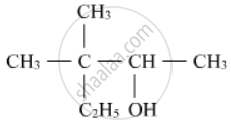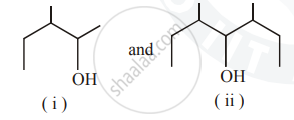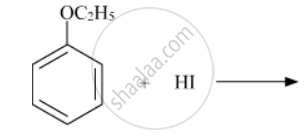Please select a subject first
Advertisements
Advertisements
What happens when a freshly prepared precipitate of Fe(OH)3 is shaken with a small amount of FeCl3 solution?
Concept: Properties of Colloidal Solutions
What happens when persistent dialysis of a colloidal solution is carried out?
Concept: Properties of Colloidal Solutions
What happens when an emulsion is centrifuged?
Concept: Properties of Colloidal Solutions
(A), (B) and (C) are three non-cyclic functional isomers of a carbonyl compound with molecular formula C4H8O. Isomers (A) and (C) give positive Tollens' test whereas isomer (B) does not give Tollens' test but gives positive Iodoform test. Isomers (A) and (B) on reduction with Zn(Hg)/conc. HCl give the same product (D).
1) Write the structures of (A), (B), (C) and (D).
2) Out of (A), (B), and (C) isomers, which one is least reactive towards the addition of HCN?
Concept: Bonding in Metal Carbonyls
Write the structures of the main products in the following reactions :

Concept: Importance and Applications of Coordination Compounds
What type of isomerism is exhibited by the complex `[Co(NH_3)_5Cl]SO_4`?
Concept: Isomerism in Coordination Compounds > Structural Isomerism
Write the hybridisation and number of unpaired electrons in the complex `[CoF_6]^(3-)`. (Atomic No. of Co = 27)
Concept: Bonding in Coordination Compounds > Valence Bond Theory (VBT)
Write the chemical reactions involved in the process of extraction of Gold. Explain the role of dilute NaCN and Zn in this process.
Concept: Types of Separation or Concentration of an Ore > Leaching
Write the structures of the main products in the following reactions :

Concept: Introduction to Haloalkanes and Haloarenes > Nomenclature
What happens when: XeF4 reacts with SbF5?
Concept: P - Block Group 18 Elements > Concept of Group 18 Elements
Out of chlorobenzene and benzyl chloride, which one gets easily hydrolysed by aqueous NaOH and why?
Concept: Compounds of Halogens
Write the IUPAC name of the following :

Concept: Alcohols, Phenols and Ethers > Nomenclature
Among the hydrides of Group-15 elements, which have the lowest boiling point?
Concept: Concept of Group 15 Elements
Among the hydrides of Group-15 elements, which have the maximum basic character?
Concept: Concept of Group 15 Elements
Among the hydrides of Group-15 elements, which have the highest bond angle?
Concept: Concept of Group 15 Elements
Among the hydrides of Group-15 elements, which have the maximum reducing character?
Concept: Concept of Group 15 Elements
Identify the chiral molecule in the following pair :

Concept: Physical and Chemical Properties of Alcohols and Phenols
Write the structure of the product when chlorobenzene is treated with methyl chloride in the presence of sodium metal and dry ether.
Concept: Compounds of Halogens
Write the structure of the alkene formed by dehydrohalogenation of 1-Bromo-1methylcyclohexane with alcoholic KOH.
Concept: Compounds of Halogens
Write the structures of the main products in the following reactions :

Concept: Chemical Reaction of Ethers - Cleavege of C-O Bonds
